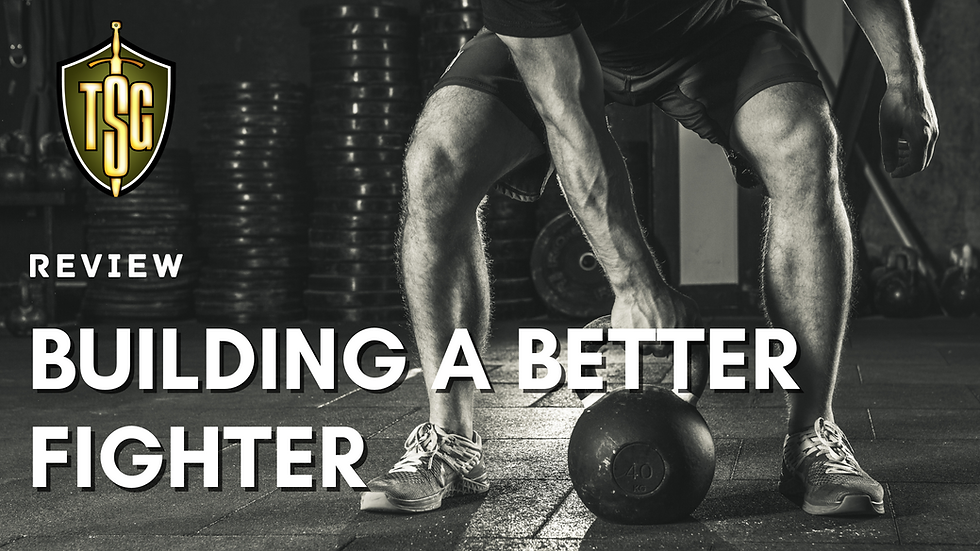Review: MMA Strength & Conditioning Guide to Building a Better Fighter
- Brad Parker

- Sep 26, 2020
- 4 min read
Updated: Jun 6, 2024

We are going to take a dive into the book:

The author is Phil Daru, a strength and conditioning coach probably best known for his association with American Top Team (ATT). He was as a professional fighter with ATT for eight years and then the gym’s strength and conditioning coach before founding Daru Strong in Boca Raton. He has trained champion fighters such as Joanna Jedrzejczyk, Junior Dos Santos, Dustin Poirer, Tecia Torres, and Colby Covington.
Phil qualifies this book as a guide for trainers/coaches and fighters trying to take their Mixed Martial Arts game “to the next level”.
His promises to improve strength, power, flexibility, coordination, and mental toughness through proper programming and timing of different exercises to prepare you for the cage.
First and foremost, this book is specific to its title. It's all about building strength and conditioning. It's not about any of the skills required to make you a better fighter. It's about building the physical and mental attributes which serve as a foundation for you as a fighter. In other words, there are no references to anything like how to counter a triangle choke or how do use angles to defeat a striker.
This book is solely about building your base power and conditioning along with any additional training you are doing to enhance your actual fighting skills.
There are very few references to skills inside of the cage as Phil focuses on your specific physical preparation. True to his promise of being for trainers and coaches, he does allow room inside this program for the necessary skill-based training for fighters preparing for a match. Examples include his schedule for conditioning workouts to change to allow fighters more time to train skills.
The timing of the program is based on your status of being either in “fight camp” or “off-season”. The structure of this program that assumes you are either a professional or very serious amateur in MMA.
For example, the broad programming assumes these elements for off-season:
Train 2 to 3 times a week.
Train for strength with high intensity and less volume.
Longer and less intense cardio training.
Train no longer than 90 minutes in a single session.
When in fight camp between 12 to 6 weeks out from the fight:
Train 3 times a week.
Focus 2 days on strength and power.
Focus the third day on muscular endurance work.
When in fight camp between 6 to 2 weeks out from the fight:
Cut conditioning training to 2 times a week (allows more days for skills-specific training).
Focus on flexibility.
Train for muscular endurance with high intensity exercises.
Train cardio with fight-specific movements like bag work, shadowboxing, sprawls, ground and pound.
Cut all high-intensity training one week out and focus on recovery and mental focus.
For strength and power training, you won't be surprised when he recommends you eat your vegetables with these main lifts and exercises:
Squat
Deadlift
Overhead Press
Floor Press
Box Jumps
The interesting variation here is the floor press instead of a bench press. Phil puts you in a more fight-related position for this exercise designed to build your upper body strength. Here you are going to lie on the floor with your elbows tucked into the sides and your shoulder blades pinched together. He says you can either keep your feet flat on the floor like you are going to bridge or keep your legs flat. In the video below, you see him demonstrating with a barbell and he keeps his legs flat. Use bands or chains to press up from the floor in a series of 1 to 3 repetitions for 3 to 5 sets. He also recommends using a training partner of the same weight class as a sort of dummy. I think this provides a superior experience because it's more realistic. The author recommends throwing in 1 to 2 minute burn outs of continuous pressing on your live partner.
Here’s Phil teaching us why and how to do the floor press. Note the first part of this video is teaching us a really good variation of the squat called the Zercher Squat.
I'll throw in the observation that these options help protect your shoulders (which have probably suffered a number of years of kimuras) and your neck (which have a similar number of years of being stacked up when your guard has been passed or defending against your triangle). They are nice options to have to work around injuries.
Pros
Concise.
Specific.
Directed to fighters. There are many strength and conditioning books out there, but very few for making you a stronger, faster, combat athlete with a deeper gas tank.
Cons
Some minor spelling and grammatical mistakes. However, we are looking for Phil's expertise in strength and conditioning here, not his English class expertise.
So you're not a professional? How much would you be willing to pay to have someone give you a roadmap the professionals use to get ready for their fights? That might be how you should approach this program.
Bottom Line?
If you've tried other programs and not seen good results, give this a try. Come on, for $2.99? It's a steal.



Comments